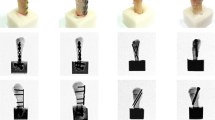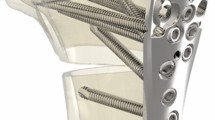Abstract
Humeral shaft fracture is one of the most common fractures in older adults. For humeral shaft fractures, a fixed treatment is performed using a straight plate. A straight locking plate is designed such that it can be inserted at a right angle (to the fractured bone), and the screw hold angles are designed to facilitate perpendicular insertion, which may lead to nonunion, such as a pull-out or breakage. Herein, a screw was inserted to the plate, and changes in gripping force with varying angles of screw placement was investigated with an aim to optimize the incision site. Finite element analysis was used to determine the stress of plates and screws under three conditions (load, tensile, and bending) which were applied to 13 plate models with varying screw angle combined with the humeral shaft fracture model. The results showed that the von Mises stress of the plates and screws at the same pressure was the highest when both the screws were positioned at an angle of 5° to the plate at the top and bottom, rather than the conventional vertical screw insertion. In conclusion, it was confirmed that by varying the angle of the plate insertion screw to minimize the incision site, the fixation strength could be further increased. If these results are applied to actual procedures, it is expected that they will not only minimize the scope of incision for plate fixation but also reduce side effects such as bone and screw joint breakage after the procedure.




Similar content being viewed by others
References
Tytherleigh-Strong, G., Walls, N., & McQueen, M. M. (1998). The epidemiology of humeral shaft fractures. Journal of Bone and Joint Surgery. British Volume, 80(2), 249–253. https://doi.org/10.1302/0301-620x.80b2.8113
Mann, R. J., & Neal, E. G. (1965). Fractures of the shaft of the humerus in adults. Southern Medical Journal, 58(1), 264–268. https://doi.org/10.1097/00007611-196503000-00002
Court-Brown, C. M., Rimmer, S., Prakash, U., & McQueen, M. M. (1998). The epidemiology of open long bone fractures. Injury, 29(7), 529–534. https://doi.org/10.1016/s0020-1383(98)00125-9
Neer, C. S. (1970). Displaced proximal humerus fractures: Part 1 classification and evaluation. Journal of Bone & Joint Surgery, 52(6), 1077–1089.
Brumback, R. J., Bosse, M. J., Poka, A., & Burgess, A. R. (1986). Intramedullary stabilization of humerus shaft fractures in patients with multiple trauma. Journal of Bone and Joint Surgery. British Volume, 68(1), 960–970.
Bell, M. J., Beauchamp, C. G., Kellam, J. K., & McMurtry, R. Y. (1985). The results of plating humeral shaft fractures in patients with multiple injuries: The Sunnybrook experience. Journal of Bone and Joint Surgery. British Volume, 67(2), 293–296. https://doi.org/10.1302/0301-620X.67B2.3980544
Cornell, C. N., Levine, D., & Pagnani, M. J. (1994). Internal fxation of proximal humerus fractures using the screw-tension band technique. Journal of Orthopaedic Trauma, 8(1), 23–27. https://doi.org/10.1097/00005131-199402000-00006
Lipton, H. A., & Wollstein, R. (1996). Operative treatment of intraarticular distal radial fractures. Clinical Orthopaedics and Related Research, 327, 110–124. https://doi.org/10.1097/00003086-199606000-00016
Lewis, G. S., Mischler, D., Wee, H., Reid, J. S., & Varga, P. (2021). Finite element analysis of fracture fixation. Current Osteoporosis Reports, 19(4), 403–416. https://doi.org/10.1007/s11914-021-00690-y
Park, S. G., & Shon, O. J. (2017). Impaired bone healing metabolic and mechanical causes. Journal of Korean Fracture Society, 30(1), 40–51. https://doi.org/10.12671/jkfs.2017.30.1.40
Antoniac, I. V., Stoia, D. I., Ghiban, B., Tecu, C., Miculescu, F., Vigaru, C., & Saceleanu, V. (2019). Failure analysis of a humeral shaft locking compression plate: Surface investigation and simulation by finite element method. Materials, 12(7), 1128–1146. https://doi.org/10.3390/ma12071128
Uchiyama, Y., Handa, A., Omi, H., Hashimoto, H., Shimpuku, E., Imai, T., Takatori, N., & Watanabe, M. (2021). Locking versus nonlocking superior plate fixations for displaced midshaft clavicle fractures: A prospective randomized trial comparing clinical and radiografic results. Journal of Orthopaedic Science, 26(1), 1094–1099. https://doi.org/10.1016/j.jos.2020.09.017
Hou, S.-M., Hsu, C.-C., Wang, J.-L., Chao, C.-K., & Lin, J. (2004). Mechanical tests and finite element models for bone holding power of tibial locking screws. Clinical Biomechanics, 19(1), 738–745. https://doi.org/10.1016/j.clinbiomech.2004.04.012
Pan, X.-H., Chen, W.-C., Lin, K.-J., Lin, K.-P., Tsai, C.-L., & Wei, H.-W. (2019). Effect of semi-rigid locking screws on the stiffness of a fracture-fixation construct: A conceptual finite-element study. Advances in Mechanical Engineering, 11(6), 1–7. https://doi.org/10.1177/1687814019854577
Chen, H., Yin, P., Wang, S., Li, J., Zhang, L., Khan, K., & Tang, P. (2018). The augment of the stability in locking compression plate with intramedullary fibular allograft for proximal humerus fractures in elderly people. BioMed Research International, 18(2), 1–8. https://doi.org/10.1155/2018/3130625
Ko, M. S., Kang, G. R., Kim, J. S., Pak, H. N., Choe, G. R., & Ra, J. M. (2019). A biomechanical analysis of intramedullary nailing for humeral shaft fractures using 3D-finite element method. Biomed Research International, 4(36), 36–46. https://doi.org/10.21037/amj.2019.09.02
Jeong, J. Y., Jason, B., & Iannotti, J. P. (2017). Effect of a variable prosthetic neck-shaft angle and the surgical technique on replication of normal humeral anatomy. Journal of Bone and Joint Surgery. American Volume, 91(8), 1932–1941. https://doi.org/10.2106/JBJS.H.00729
Canale S. T., & Beaty James H. (2013) Campbell's Operative Orthopaedics, 12th ed, 2846
Zderic, I., Willhuber, G. C., Ahrend, M.-D., Gras, F., Barla, J., Sancineto, C., Windolf, M., Richards, G., & Gueorguiev, B. (2019). Biomechanical comparison between standard and inclined screw orientation in dynamic hip screw side-plate fixation: The lift-off phenomenon. Journal of Orthopaedic Translation, 18(1), 92–99. https://doi.org/10.1016/j.jot.2018.10.005
Sano, H., Wakabayashi, I., & Itoi, E. (2006). Stress distribution in the supraspinatus tendon with partial-thickness tears: An analysis using two-dimensional finite element model. Journal of Shoulder and Elbow Surgery, 15(1), 100–105. https://doi.org/10.1016/j.jse.2005.04.003
Tingart, M. J., Apreleva, M., von Stechow, D., Zurakowski, D., & Warner, J. J. (2003). The cortical thickness of the proximal humeral diaphysis predicts bone mineral density of the proximal humerus. Journal of Bone and Joint Surgery. British Volume, 85(4), 611–617. https://doi.org/10.1302/0301-620x.85b4.12843
Zhang, Q. H., Tan, S. H., & Chou, S. M. (2006). Effects of bone materials on the screw pull-out strength in human spine. Medical Engineering & Physics, 28(8), 795–801. https://doi.org/10.1016/j.medengphy.2005.11.009
Stoffel, K., Stachowiak, G., Forster, T., Gächter, A., & Kuster, M. (2004). Oblique screws at the plate ends increase the fixation strength in synthetic bone test medium. Journal of Orthopaedic Trauma, 18(9), 611–616. https://doi.org/10.1097/00005131-200410000-00006
Stoffel, K., Dieter, U., Stachowiak, G., Gächter, A., & Kuster, M. S. (2003). Biomechanical testing of the LCP–how can stability in locked internal fixators be controlled? Injury, 34, 11–19. https://doi.org/10.1016/j.injury.2003.09.021
Sharir, A., Barak, M. M., & Shahar, R. (2008). Whole bone mechanics and mechanical testing. Open Veterinary Journal, 177(1), 8–17. https://doi.org/10.1016/j.tvjl.2007.09.012
Acknowledgements
This study was supported by the Konyang University Research Fund. This study was also supported by a grant from the Korea Health Technology R&D Project through the Korea Health Industry Development Institute (KHIDI), funded by the Ministry of Health & Welfare, Republic of Korea (Grant No.: HI17C2412).
Funding
Funding was supported by Konyang University, Ministry of Health & Welfare, Republic of Korea (Grant No. HI17C2412).
Author information
Authors and Affiliations
Corresponding author
Additional information
Publisher's Note
Springer Nature remains neutral with regard to jurisdictional claims in published maps and institutional affiliations.
Rights and permissions
About this article
Cite this article
Yi, J.W., Kim, J.U., Kim, A.Y. et al. Evaluating the Stability of Locking Screw on Locking Compression Plate According to Various Screw Insertion Angles. Int. J. Precis. Eng. Manuf. 23, 789–796 (2022). https://doi.org/10.1007/s12541-022-00652-z
Received:
Revised:
Accepted:
Published:
Issue Date:
DOI: https://doi.org/10.1007/s12541-022-00652-z




